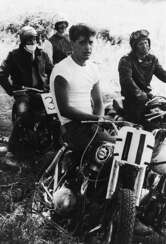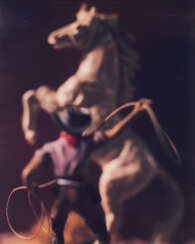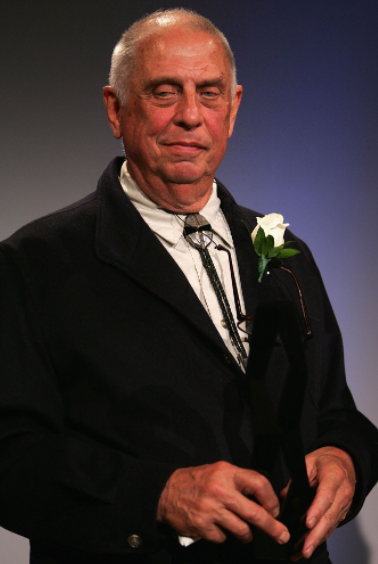
Photography — 1168: Made in America

Jeanne Dunning is an American photographer whose work is centered around corporeality and human physicality in abstract forms. Dunning earned her Bachelor of Arts from Oberlin College and her Masters of Fine Arts from The School of the Art Institute of Chicago. From there, she opened her first exhibit at the Feature Gallery in Chicago in 1987. In the early 1990s, Dunning created a series of photographs for an exhibit titled "Directions" which was meant to blur the lines of fact and fiction.The exhibit was displayed at the Hirshhorn Museum in Washington. Dunning's work is included in the permanent collections of the Art Institute of Chicago, the Whitney Museum of American Art, the Museum of Contemporary Art, Chicago, the Museum of Contemporary Photography and the Museum of Modern Art, New York.

Jeanne Dunning is an American photographer whose work is centered around corporeality and human physicality in abstract forms. Dunning earned her Bachelor of Arts from Oberlin College and her Masters of Fine Arts from The School of the Art Institute of Chicago. From there, she opened her first exhibit at the Feature Gallery in Chicago in 1987. In the early 1990s, Dunning created a series of photographs for an exhibit titled "Directions" which was meant to blur the lines of fact and fiction.The exhibit was displayed at the Hirshhorn Museum in Washington. Dunning's work is included in the permanent collections of the Art Institute of Chicago, the Whitney Museum of American Art, the Museum of Contemporary Art, Chicago, the Museum of Contemporary Photography and the Museum of Modern Art, New York.

Doug Hall is an American photographer and media artist, who has received national and international recognition for his work in a range of practices including performance, installation, video, and large scale digital photography. He was a member of T. R. Uthco Collective (1970–1978). From 1981 to 2008, he was a member of faculty in the New Genres Department at the San Francisco Art Institute (SFAI). After retiring from the SFAI, he joined the Graduate Fine Arts faculty at the California College of the Arts (CCA) from 2008 to 2015.

Laurie Simmons is an American artist, photographer and filmmaker. Since the mid-1970s, Simmons has staged scenes for her camera with dolls, ventriloquist dummies, objects on legs, and people, to create photographs that reference domestic scenes. She is part of The Pictures Generation, a name given to a group of artists who came to prominence in the 1970s. The Pictures Generation also includes Cindy Sherman, Barbara Kruger, and Louise Lawler.

Danny Lyon is an American photographer and filmmaker.
All of Lyon's publications work in the style of photographic New Journalism, meaning that the photographer has become immersed in with, and is a participant of, the documented subject. He is the founding member of the publishing group Bleak Beauty.
After being accepted as the photographer for Student Nonviolent Coordinating Committee (SNCC), Lyon was present at almost all of the major historical events during the Civil Rights Movement.

Danny Lyon is an American photographer and filmmaker.
All of Lyon's publications work in the style of photographic New Journalism, meaning that the photographer has become immersed in with, and is a participant of, the documented subject. He is the founding member of the publishing group Bleak Beauty.
After being accepted as the photographer for Student Nonviolent Coordinating Committee (SNCC), Lyon was present at almost all of the major historical events during the Civil Rights Movement.

David Lawrence Levinthal is an American photographer who lives and works in New York City. He uses small toys and props with dramatic lighting to construct miniature environments for subject matters varying from war scenes to voyeurism to racial and political references to American pop culture. Levinthal has produced a diverse oeuvre, utilizing primarily large-format Polaroid photography.

David Lawrence Levinthal is an American photographer who lives and works in New York City. He uses small toys and props with dramatic lighting to construct miniature environments for subject matters varying from war scenes to voyeurism to racial and political references to American pop culture. Levinthal has produced a diverse oeuvre, utilizing primarily large-format Polaroid photography.

Louis Faurer was an American candid or street photographer. He was a quiet artist who never achieved the broad public recognition that his best-known contemporaries did; however, the significance and caliber of his work were lauded by insiders, among them Robert Frank, William Eggleston, and Edward Steichen, who included his work in the Museum of Modern Art exhibitions In and Out of Focus (1948) and The Family of Man (1955).

Doug Hall is an American photographer and media artist, who has received national and international recognition for his work in a range of practices including performance, installation, video, and large scale digital photography. He was a member of T. R. Uthco Collective (1970–1978). From 1981 to 2008, he was a member of faculty in the New Genres Department at the San Francisco Art Institute (SFAI). After retiring from the SFAI, he joined the Graduate Fine Arts faculty at the California College of the Arts (CCA) from 2008 to 2015.

Steven Ketchum is a contemporary American artist. His artwork is a reflection of confusion seen in the world. The figures in his drawings either don't understand themselves or each other. He also reflects and meditates on how cultures / civilizations are built and, given enough time, destroyed.

Nan Goldin is an acclaimed American photographer renowned for her profound visual narratives that delve into her personal world, marked by themes of addiction, sexuality, and intimate relationships. Born in Washington, D.C., in 1953, Goldin's journey into photography began in the early 1970s, capturing the lives of those around her, forming a "substitute family" amid a backdrop of drugs, sex, and violence.
One of Goldin's most celebrated works, "The Ballad of Sexual Dependency" (1986), is a raw and intimate portrayal of her "tribe," documenting their lives through the late 70s and early 80s in New York City. This work, initially presented as a slideshow, captures moments of love, sexuality, and domestic life, transcending into a poignant narrative of the era's challenges, particularly the AIDS crisis.
Throughout her career, Goldin's photography has continued to evolve, exploring various themes and mediums, including film. Her work, deeply personal and often autobiographical, challenges conventional perceptions of beauty, identity, and relationships, offering a window into the complexities of human connection and the essence of her subjects.
Goldin's influence extends beyond the art world, with her activism, particularly against the opioid crisis, marking another significant chapter in her journey. Her profound empathy and commitment to portraying the raw, unfiltered realities of life resonate through her extensive body of work, which continues to be celebrated in exhibitions and collections globally.
For art collectors and enthusiasts, Goldin's work offers not just aesthetic value but also deep emotional and historical resonance. To stay informed about Nan Goldin's works and related updates, signing up for newsletters from prominent galleries or her exhibitions could provide valuable insights and opportunities for engagement with her art.

Steve Rodney McQueen is a British film director, film producer, screenwriter, and video artist. He won the Academy Award for Best Picture at the 2014 Academy Awards for his work on 12 Years a Slave. He studied at Chelsea College of Art and Design, Goldsmiths College in London and Tisch School in New York. In 1999, he received a grant from the Berlin Artist Program of the German Academic Exchange Service (DAAD). In 1999 he received the Turner Prize for his photography and installations. His first films are experimental, minimalist, black-and-white and silent films (Buster Keaton). In 2003, the British Imperial War Museum named McQueen the official war artist of the Iraq War. Following his time in Iraq in 2006, the Queen and Country Project was created, featuring portraits of fallen British soldiers on a sheet of stamps.






























